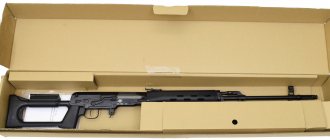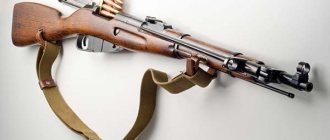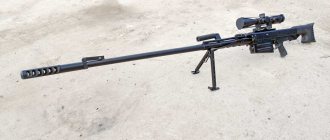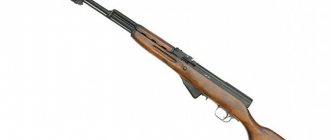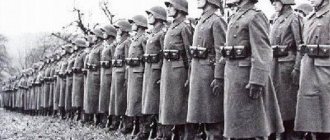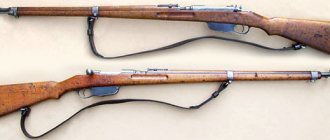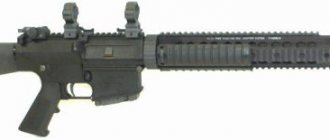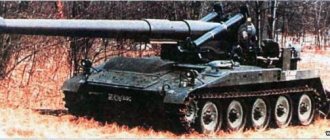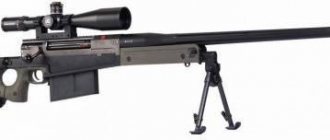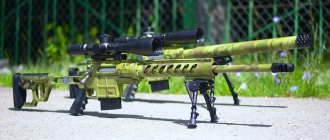Even those who are far from the world of weapons know about this legendary rifle. Mosinka has a rich history. It appeared back in 1891 and was used by the army first of the Russian Empire and then of the Soviet Union for more than 50 years. This weapon remains relevant today. For military purposes, sniper rifles based on the Mosin three-line are used. The Mosinka can also be used for hunting. This is a very reliable, inexpensive rifle that is suitable for hunting medium and large game.
History of the Mosin rifle
The Model 1891 three-line rifle, more often referred to simply as the Mosin rifle, "Mosinka" or three-line rifle, was adopted for service in 1891. It was used en masse from 1892 until the end of the 50s of the 20th century. During this time, the rifle underwent modernization several times. It is called three-line because of its caliber, which is equal to three lines. This is a traditional length measure equal to 2.54 mm.
- Russian designer Sergei Ivanovich Mosin presented the first version of his famous three-line design in 1889. It was developed on the basis of his earlier single-shot rifle, from which it borrowed the receiver and bolt group unchanged. But in order to adopt it for service, the Russian army needed to change the design of the bolt group and magazine, which was done. In 1892, production of this version of the rifle began at the Izhevsk, Tula and Sestroretsk arms factories. Since their capacity was not enough, Mosinki at this time were also produced at a plant in the French city of Chatellerault;
- in combat conditions, the three-line gun was first used in 1893 during the battle with the Afghans in the Pamirs. The first stage of rearmament of the Russian army with Mosinka was completed in 1897. Subsequently, rifles adopted by the armies of other countries were quickly modernized, while the three-line rifle lagged behind them in this regard. As a result, by the First World War, the Mosinka was noticeably inferior to them in terms of characteristics;
- In the first years of Soviet power, there was a question about replacing the Mosin rifle with a more advanced one or modernizing it. The second option was chosen because after changes were made to the design, the Mosinka could meet the requirements for this class of weapon. At the same time, the development of a new repeating rifle was pointless, since repeating rifles were an obsolete type of weapon. As a result of the 1924 modernization, the Mosin rifle model 1891/30 appeared. In 1928, the USSR began producing optical sights for it.
- in 1938, another modification of the Mosinka was developed - the 1938 model carbine. It was designed for targeted shooting at a range of up to 1000 m;
- The next modification adopted by the Red Army was the 1944 carbine. It was distinguished by simplified manufacturing technology and the presence of a permanent bayonet. After its adoption, the Mosin rifle model 1891/30 was discontinued.
Before you is a watered-down version of the famous “three-line”, a popular weapon during the October Revolution. The Mosin sniper rifle was in service with the Red Army during the Great Patriotic War. This legendary weapon used a rack and pinion type magazine, which was created by Russian designer Sergei Mosin back in the 80s of the 19th century. The Russian designer received many commercially profitable offers. But he categorically rejected tempting ideas, deciding not to sell the invention outside his country.
Since 1891, three modifications of the Mosin rifle have been used. However, in the 20s of the last century, only the dragoon model remained in demand. And at the end of the 20s, a sniper version of the rifle entered service, which gained great popularity during the Second World War.
Design Features
The Mosin sniper rifle is highly reliable. The device for feeding cartridges into the magazine is made in such a way that it is impossible for two cartridges to enter the chamber at once. This became possible thanks to a special detail - a reflector cut-off.
Features of the cooled version:
· the model is designed for firing flash-noise cartridges;
· the magazine holds 5 rounds of ammunition;
· shooting is carried out with single shots;
· assembly/disassembly of the SHP rifle is carried out in the same order as in the case of the combat version;
· critical parts of the rifle are made of high-strength weapon steel;
· the stock and butt are made of solid wood, carefully sanded and coated with a protective varnish;
· The sniper rifle is equipped with an optical sight, is 114 cm long and weighs 4.2 kg.
Shooting from a deactivated rifle
A cooled weapon creates only a high-quality imitation of a combat shot. When you pull the trigger, gas and flames fly out of the muzzle. An empty cartridge case and a characteristic pop also make the shot look like a combat shot.
The owner of a cold sniper rifle must remember the safety rules. It is dangerous to point the muzzle of a weapon at a person, since firing with blank cartridges is traumatic. It can cause severe burns, deprive a person of vision and even kill when fired at point-blank range.
The use of the model for combat purposes is excluded, since the manufacturer has resorted to the following measures:
· metal pins are welded inside the barrel, through which only fire and gas can pass, but not solid objects;
· the chamber is bored out specifically for the use of flash-noise cartridges;
· the rifling characteristic of combat rifle barrels has been ground down.
Area of use of the cold sniper rifle
A cold rifle can be used in cultural events, during theatrical performances and when filming movies and videos. The model is also relevant for reconstructions of military operations. With the help of a deactivated weapon, beginners can learn how to operate a rifle and assemble and disassemble the model. In addition, the legendary Mosin rifle will decorate any weapons collection and occupy one of the central places in it.
The Mosin sniper rifle comes with a scope, passport and box. If you decide to purchase a cooled SVM for yourself or as a gift, we are happy to advise you and arrange delivery to any region of Russia. Our online store has attractive prices. We offer convenient payment methods and process orders promptly.
Design
The Mosin rifle has a barrel with 4 grooves. In its rear part there is a chamber with smooth walls. Also at this end of the barrel there is a threaded stump; the receiver in which the bolt is placed is tightly screwed onto it. A magazine box with a feed mechanism, a cut-off reflector and a trigger mechanism are attached to the bolt.
The cartridges inside the magazine are arranged in one row. The reflector cut-off separates the cartridges that are in the magazine box and the cartridge in the barrel. This ensures that there are no delays in feeding that could be caused by the rims of the ammunition catching on each other. This detail also reflects spent cartridges. The reflector cut-off is one of the key elements of the rifle, which was introduced into the design by Mosin. Thanks to it, the rifle works flawlessly in any conditions.
Components of the trigger mechanism:
- hook;
- trigger spring, which also serves as a sear;
- screw;
- hairpin.
The trigger of the Mosin rifle is tight and long, without warning - the trigger stroke is not divided into two stages with different forces.
Components of a three-line shutter:
- stem with comb and handle;
- larva;
- ejector;
- trigger;
- drummer;
- action spring;
- connecting strip.
The mainspring is compressed when the bolt is unlocked by turning the handle. During locking, the firing pin rests against the sear. The firing pin can also be cocked manually with the bolt closed by pulling the hammer back. To put the rifle on safety, you need to pull the trigger back and turn it counterclockwise.
Sights
The Mosin rifle of the 1891 model was equipped with a stepped sight. On the 1891/30 modification, a sector sight was installed. It consists of an aiming bar with a clamp, an aiming block and a spring, and is marked at a distance of up to 2000 m. The rear sight can be installed in any position from 50 to 2000 m, the step is 50 m. The front sight on the 1891/30 rifle received a ring muzzle.
To fully unleash the potential of the Mosin rifle, it is necessary to install an optical sight on it. Owners of this weapon can bet on it like anything, but the situation is complicated by the fact that it was not originally intended for use with optical sights. It is important to choose optics that will not interfere with the use of open sights.
A good solution may be to install a “native” PU optical sight using a Kochetov vertical base bracket. In this way you can get the most authentic and harmonious externally weapon.
Another option is to use modern mounts and modern optical sights.
Operating principle of the Mosin rifle
To charge the three-line, you need to:
- turn the shutter handle to the left;
- pull the shutter all the way back;
- insert the clip into the receiver;
- drown the cartridges, throw away the clip;
- move the shutter forward;
- turn the shutter handle to the right.
Then all that remains is to pull the trigger to fire. To fire the next shot, simply repeat steps 1, 2, 3, 5 and 6. Four cartridges are fed from the clip into the magazine, the fifth into the receiver. After closing the bolt, it ends up in the chamber.
Characteristics
| Brand: | Hammer Arms |
| Model: | KO-91/30 |
| Product weight, g: | ~4500 |
| Caliber: The caliber of a smoothbore weapon is determined by the internal diameter of the barrel. For example, a barrel 18 calibers long. The caliber number refers to the number of spherical bullets that can be cast from 1 English pound of lead (453.592 g). Bullets are spherical in shape, identical in mass and diameter, which is equal to the internal diameter of the barrel in its middle part. The smaller the bore, the more bullets can be produced from a pound of lead.
| 9.6×53 Lancaster |
| Drill type: | Lancaster |
| Butt material (stock): | tree |
| Number of trunks: | single-barreled |
| Operating principle: | longitudinally sliding |
| Magazine Capacity: The number of rounds that can fit into a magazine. There are designations for magazine capacity, for example, 4+1 - this means that the magazine contains 4 cartridges, and another 1 is placed in the chamber. More details | |
| Barrel length, mm: | 720 |
| Total length, mm: | 1220 |
| Country of manufacture: | Russia |
| Brand Country: | RUSSIA |
Versions and modifications
The Mosin rifle is a weapon intended for military purposes. Some people use these military three-ruler rifles for hunting. Various modifications of the Mosin rifle and carbines created on its basis were developed specifically for hunting purposes - primarily the KO-91/30, OTs-48 and Los carbines.
Carbine KO-91/30
A rifle designed for hunting medium and large-sized animals. Main characteristics of KO-91/30:
- length – 1232 mm;
- barrel length – 745 mm;
- weight – 4.0 kg;
- caliber – 7.62 mm;
- cartridge used - 7.62x54R;
- Magazine capacity – 5 rounds.
The rifle is designed for shooting at a distance of up to 300 m. You can also install an optical sight on it, which, once installed, does not interfere with open use. Recharging is done manually. The design feature of this rifle lies in the safety mechanism that protects against premature firing.
Carbine OTs-48
The OTs-48K sniper rifle was developed by the Tula TsKIB for sporting and hunting weapons in 2000. It was created for the needs of the Ministry of Internal Affairs troops and special forces. The rifle showed excellent results in tests both in terms of firing range and accuracy of fire. It can be aimed at 1300 m, while at a distance of 100 m the spread of bullets does not exceed 3.5 m. For the Dragunov sniper rifle, these figures are 1000 m and 8 cm, respectively.
The OTs-48, in turn, is a hunting carbine based on the Mosin rifle, which is intended for hunting large game. It is designed to use 7.62x54R cartridges. The barrel and locking assembly remained from the Mosin rifle, and the stock and stock were replaced with modern ones. Unlike OTs-48K, which is produced only in small quantities on special orders, OTs-48 went into mass production and turned into a fairly recognizable brand.
Carbine KO-8.2
An 8.2 mm caliber rifle, which was developed for cartridges with semi-jacketed bullets and was produced in the USSR. Its other characteristics:
- rifle length – 1010 mm;
- barrel length – 520 mm;
- weight – 3-3.6 kg;
- magazine capacity – 5 rounds;
- bullet starting speed – 440 m/s.
Designed for hunting medium and large animals. Reloaded manually, trigger without warning. There is also a modification of the KO-8.2M, which has a different rifling pitch, has an active sector sight and a different stock shape.
Carbine KO-38
A hunting rifle, which was created on the basis of a carbine of the 1938 model and was produced in the USSR.
Carbine KO-44
A hunting carbine developed on the basis of a military carbine of the 1944 model, which was produced in the USSR.
Carbine "Los-7-1"
The “Los” family of hunting weapons was developed in the USSR largely on the basis of the Mosin three-line rifle. Main characteristics of the Los-7-1 carbine:
- barrel length – 550 mm;
- weight – 3.5 kg;
- caliber – 7.62 mm;
- cartridge used – 7.62×51 mm;
- Magazine capacity – 5 rounds.
On sale you can find modifications of the Los-7-1 carbine for different types of imported cartridges.
Among experts, opinions about the Mosinka and carbines created on its basis differ. But they are quite popular and suitable for fishing for medium and large game. The main advantages that distinguish the Mosin hunting carbine are the highest reliability and affordable price. This weapon is used by many professional hunters. Thanks to the release of updated versions such as the OTs-48, this combat system still remains relevant.
Chilled SHP sniper rifle Mosin KO-91/30-SKh (SO-SVM PU) 7.62×54
Characteristics:
| Manufacturer: | OJSC "Ruzhya TOZ" (Tula, Russia) / LLC "Molot-Weapon" (Vyatskie Polyany, Russia) |
| Caliber: | 7.62 mm |
| Combat prototype: | Mosin sniper rifle model 1891/1930. (Russia) |
| Ammunition: | light and sound cartridges 7.62×54 |
| Magazine capacity: | 5 |
| Blowback (?): | No |
| Material: | metal, wood |
| Shooting mode (?): | single |
| Length: | 1235 mm, barrel - 729 mm |
| Weight: | 4270 g |
| Equipment (?): | carbine, sight, passport (instructions), box |
| Certificate: |
Description of an empty Mosin sniper rifle with a scope:
The SHP-cleaned Mosin sniper rifle (SO-SVM) , 7.62x54, is a deactivated modification of the famous “three-line”, which was not only a rifle of the October Revolution, but was also used by soldiers of the Soviet army throughout the Second World War. Back in the 80s of the 19th century, Mosin developed the design of a rack and pinion magazine for an 8 mm rifle, and this invention was used in a new rifle.
They say that the designer received very tempting offers to sell his invention, but firmly decided that the rifle should only be Russian. The deflector cut-off is a rifle element that ensures reliable supply of ammunition to the magazine; its design eliminates the possibility of two cartridges entering the chamber at the same time. Since 1891, there have been three modifications of the rifle, but by the 20s of the new century only the dragoon model had taken root. At the end of the 20s of the 20th century, a sniper modification of the “three-line” was developed, which showed excellent results in the battles of World War II.
The cooled SHP is a specimen designed for use with flash-noise cartridges. The magazine holds 5 rounds of ammunition and can fire exclusively with single shots. Disassembly and assembly of the rifle is completely similar to the combat version. For the purpose of deactivation, the following changes were made to the design of the Mosin combat rifle:
- pins have appeared in the barrel cavity, thereby eliminating the possibility of live cartridges passing through it;
- the rifling present in the barrels of combat models was removed;
- The chamber size has been increased to accommodate flash-bang cartridges.
The body, barrel and all critical elements of this specimen are made of good weapon steel, and the butt and stock are made of wood, similar to combat models. The modification is equipped with an optical sight. This “three-ruler” weighs 4.2 kg and is 1.14 m long.
The bolt is locked on two lugs by rotating the bolt around its axis. The trigger mechanism ensures the production of an imitation of a single shot and setting the safety cock.
The weapon is a decommissioned, cold hunting carbine "KO-30S" - model "KO-91/30-СХ" can be used for cultural and educational purposes, as an original collector's item, and is also suitable for use in the process of reconstruction of military events.
Video review:
Information about the characteristics, configuration, appearance and color of the product is for informational purposes only.
; they are subject to change by the manufacturer without notice.
In the online store pnevmat24.ru you can buy a cold SHP sniper rifle Mosin KO-91/30-SKH (SO-SVM PU) 7.62×54 with convenient delivery throughout Russia by courier, transport company or Russian Post. We also deliver to Belarus. You can check the price and order the product on the website, by phone or write an e-mail.
